PR workflow modernization – The essential guide
This guide provides you with a thorough 5-step plan to evaluate and improve the workflow of your PR team.
This guide provides you with a thorough 5-step plan to evaluate and improve the workflow of your PR team.
The goal is to make your team adaptable for increasingly fast changing communication requirements. This guide will help you improve your PR workflow so that you stay current and create more value for clients in less time. The result? Better work, happier clients, and more time left to sell to other clients.
This guide is intended as your roadmap for real change in your company. It is full of practical advice to get your team on board during workshops, internal presentations, and pilot projects.
What’s ahead:
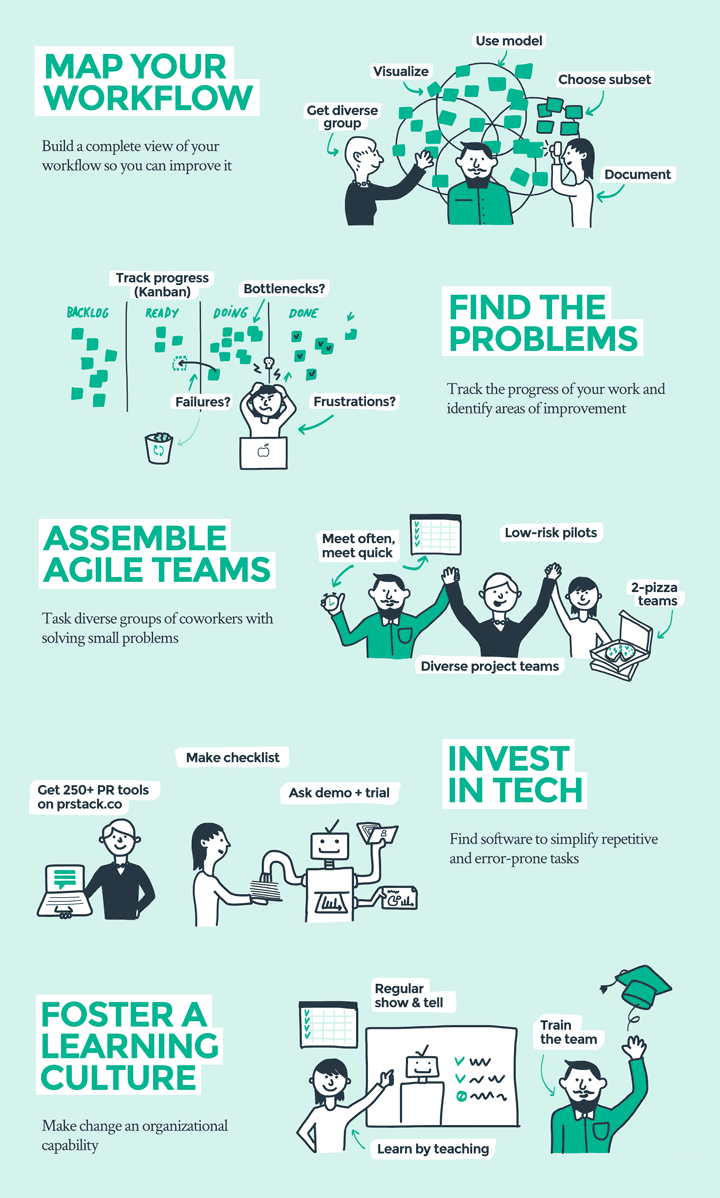
Check the full infographic on Pinterest.
Before we start with practicalities, let’s look at why your team would want to evaluate the way you work.

PR teams need to adapt to the changing consumer
The world is changing fast, and so is our profession. For example, you may be reading this guide on a tiny screen and you may have arrived here via a social network that didn’t exist only a few years ago. And meanwhile some kids in a Silicon Valley or Nairobi basement might be creating yet another social network to keep up with.
For example, 30 percent of millennial internet users in the United States regularly use Snapchat. A large part of your audience communicates via this medium. Are you up to speed?
And what about LinkedIn posts? Twitter paid amplification? Long form blog posts?
Is your team handling it?
It is a challenge to keep up. All communication teams are striving for the attention of the fickle consumer. And you are not just competing against other PR teams for budgets, but also against advertising, digital, and marketing. Everyone wants a piece of the cake.
We see many PR teams trying to get a bigger piece by expanding their skills. They are adding owned media, paid media, and shared media to their traditional earned media offering.
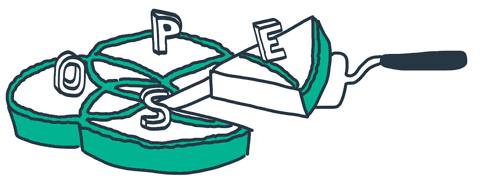
PR teams are trying to secure more of the PESO cake (Paid, Earned, Owned, and Shared media).
There is a lot of new territory to cover, and that creates a new set of expectations for your team.
The issues we face in practice are well documented: measurement, media, paid, planning, and workflow.
Stephen Waddington, Ketchum
Public relations isn’t modernising quickly enough
PR practitioners are well aware of the need to improve to keep up, yet struggle with it. For example, the team at PR Academy, a leading UK-based training organization for PR specialists, recently asked all their students to identify the skills they needed to improve upon. The highest skills gaps were reported as measurement (53%), budget management (44%), crisis management (37%), and digital communications/social media (35%).
These skill gaps are roughly the same as they were the last time the survey was done. The PR world is not being responsive enough to change, which is dangerous in this quickly changing environment.
Solving these issues won’t happen during billable hours. You will need to allocate the budget and time towards continual improvement. You will need to invest in change by putting it front and center of your team.
One of the big reasons that most agencies have not invested in reengineering their agency model is down to the money it has taken to do this (£500,000 by our last count) and also the lack of digital knowledge of most agency owners, who have grown up in a very traditional PR career.
Jim Hawker, Threepipe Digital Marketing and PR
#FuturePRoofing a Public Relations agency or a Communications team
While change is expensive and difficult, it’s absolutely necessary. The alternative is to become irrelevant and obsolete.

Why you need to improve your PR workflow
Bad workflow cripples your team: it makes it less efficient and team members end up frustrated. It means you deliver worse work slower, don’t keep clients or stakeholders as happy as they should be, and lose money.
There are many reasons for a PR workflow to be sub-par.
Doing new work requires new ways of working. And your team can be using outdated processes to solve these new problems.
Add to that the high turnover in communication teams. In 2014, turnover rates reached over 55 percent in PR agencies in the United States. Each time an employee gets replaced, knowledge is lost. New team members can misinterpret the workflows of their predecessors or create new workflows that aren’t consistent with what the rest of your organization is doing.
It may not be obvious, but it’s likely your PR workflow needs an upgrade.
If you know what to look out for, there are signs that your current workflow practices could be part of the problem. Some of the signals?
- Certain work takes longer to complete than it used to.
- Employees are frustrated with aspects of their work.
- Clients or partners send work back.
Further on we’ll look at how your team can uncover these problems.
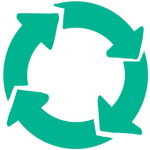
Improve continuously
When change is the new normal, your team needs to be able to adapt to it fast.
Changing your PR workflow shouldn’t be one gigantic project. Just as work needs to be broken down into manageable chunks, so must workflow improvement.
Much of the advice in this guide is inspired by tried and trusted methods from industrial production processes at Toyota. In the fifties, Toyota wrote the book on production systems and continuous improvement. Predominantly left-brained industries, like software development and internet startups, further popularized the methods of Toyota. Most noteable is the Lean Startup Movement. Now, the methods are used worldwide in numerous and diverse industries including education and social work. The right-brained communication industry is also slowly catching up.
At the foundation of TPS (The Toyota Production System) lies the Japanese concept of kaizen. It translates as the little improvement that can be done right away. Accumulated over time, many small changes create big results. In kaizen, everyone is involved in making improvements, from the CEO to the assembly line workers.
When your whole team constantly deals with change, it becomes second nature.
The future of change lies in being on the lookout for change and being sufficiently nimble to respond at the first signs of needing to change, rather than doggedly following a plan.
Scott Guthrie, Sabguthrie
A communicator’s guide to successful change management
Fortunately, PR teams may be the most equipped people to catalyze change. After all, affecting change is much about leadership and sharing a clear vision. That is what we do best.
First, let’s understand the current state of your workflow. Let’s go.
1 Map your PR workflow
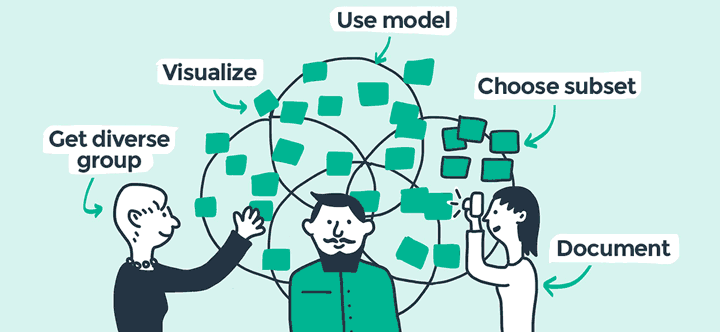
To improve something, you first need to understand the current situation. Start with building a complete view of your workflow. But don’t rush into this process. For the mapping process to make the best use of everyone’s time and yield real results, make sure you follow a few simple steps.
![]()
Assemble a workshop from a diverse group
The bigger your organization, the more workflows and processes you’ll have. People will know about different workflows and processes at different levels and in different departments.
Make sure to represent this diversity in your workshop. Invite senior managers, accounts team members, junior execs, designers, planners… the more diverse the group, the more interesting the results.
Senior managers, for example, will be able to share knowledge about macro workflows and how they fit together. Accounts colleagues will have a good understanding of where errors are made and when clients are unhappy. Juniors execs, in their turn, will have a clear idea of the groundwork involved and what’s frustrating them and holding them back.
The ideal size of your workflow innovation team depends on the size of your organization. Management is often tempted to make workshops as small as possible and only to include senior representatives. Avoid making that mistake. Make sure every level and area of the workflow you’ll tackle is represented.

Brainstorm visually to include the whole team
The typical brainstorm? A few loud people doing the talking while others look on and listen. In this circumstance, you’re usually missing out on valuable contributions from the rest of the team.
Give introverts a voice in your workshop. There are many techniques to involve all participants. One of the most effective, however, is the Post-up technique. This is an excellent method for letting everyone share ideas without fear of judgement.
It is simple: participants first write their ideas without discussion on Post-it notes. After a few minutes, everyone explains their ideas one by one and puts them on the wall. Afterwards, the participants cluster all similar ideas and create labels for each cluster.
This workshop can take up to an hour. It is intensive, so you might want to take a break after it and give the team some time to let the ideas sink in.
The workshop results in a visual overview of all the work that your team does. It is the roadmap for all your workflow improvement experiments. This overview can act as a constant visual reminder of your workflow improvement efforts, so put it in a prominent place in your office.
Give this brainstorm technique a try. It is a fun and energetic way of working that involves all team members. It gives you an ideal kickstart to a collaborative change management effort.
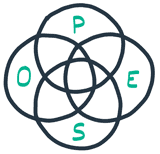
Use models for structure
Give the participants a head start by introducing a model that helps them structure their thinking.
In a communication or PR team, the PESO model is an excellent example to use as a foundation for your analysis. The model recognizes the new ways that PR teams are reaching their audiences. It goes beyond earned media by including paid media, earned media, and owned media.
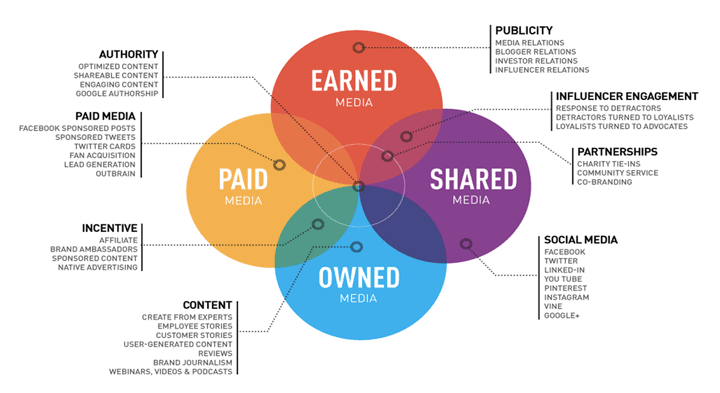
The PESO model, diagram by Spin Sucks
Use an integrated PESO model and start thinking of PR as a business driver, not just as a brand enhancer.
Gini Dietrich, Spin Sucks
PR pros must embrace the PESO model
The PESO model covers a lot of ground. It is easy to go overboard by going into too much detail. Try to keep it high level. Ask the team to only list big tasks. For example, “blogger outreach” is a high level task and “following a blogger on Twitter” isn’t.
Using the PESO model as a foundation will not only help your team understand all the work they do, but it will also reveal the work that they could do to create value for your organization.
If you’re serious about exploring the PESO model, check this PESO model kit. It are 48 inspirational cards to help you plan communication campaigns visually.
Tackle one workflow at a time
You might already feel that there’s a whole lot to cover here. In all likelihood, it will be too much for your team to improve all the workflows in the entire PESO model at once, and they shouldn’t. Mapping all your work on the PESO model is plenty for one workshop.
The complete PESO overview can act as a to do-list for subsequent workshops that dive deeper into each sub-workflow.
You can also map each sub-workflow with the Post-up technique.
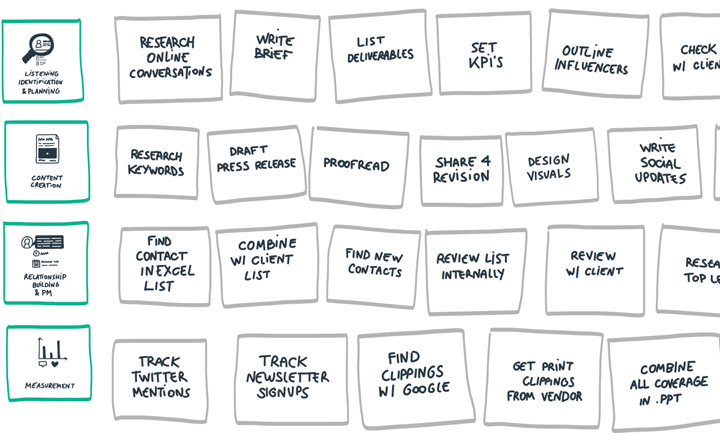
Example: snapshot of a media relations workflow mapping
At this point, you’ll have a wall full of Post-it notes.
There will be two main areas:
- The high level view of the model you are using. You could get back to that for another workshop.
- The current workflow you’re tackling, in great detail.

Document this public relations workflow overview
Keep this visual overview of your workflow. You will want to get back to the overview later in other workshops. Make sure you choose a dedicated spot, where your work will be safely preserved.
Where there is no standard, there can be no kaizen.
Taiichi Ohno (1912-1990), father of the Toyota Production System
According to Ohno, the industrial engineer that created the Toyota Production System, documenting the standard of working is the beginning and end of the kaizen process. This means that to be able to improve your processes, you need to baseline them. This workflow documentation can also be used as training material for new hires and as a quality checklist for all employees.
For now, having this workflow overview constantly visible will spur on discussion and keep workflow improvement at the top of everyone’s mind.
So what do you do now with this wall full of Post-its? Well, it isn’t altogether actionable yet…
Let’s look at how you can find areas to improve.
Like the guide so far? Share it with your network:
2Choose workflow experiments
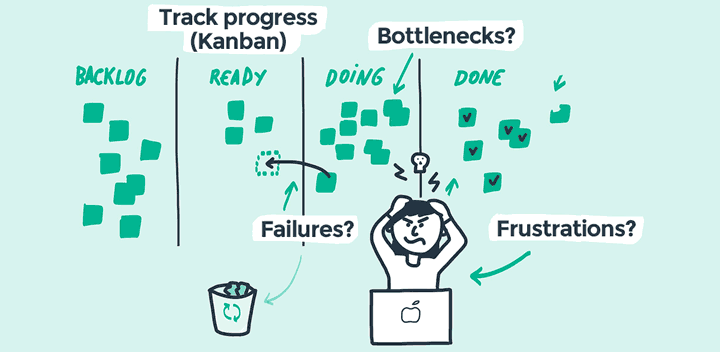
Improving PR workflow is an ongoing process. Remember the kaizen concept? Rather than going all-out and changing everything, improve one element at a time via workflow experiments.
This section looks at how you can locate problems in your workflow. The place to start is tracking your work over time.
 Track process throughput to understand what really happens
Track process throughput to understand what really happens
You can’t improve what you don’t measure.
It will be much easier to uncover errors and bottlenecks if you keep an overview of your work throughput. It will let you see what work is ready to get started, what work is in progress, and what work is done.
Kanban is ideal for this. Another method that was developed by Toyota in 1950s Japan, Kanban is a popular framework for controlling logistics. Although it was originally applied to the manufacturing process, many software development teams and service businesses have now adopted Kanban too.
PR agency FINN, based in Brussels, has been experimenting with Kanban and workflow improvement for the past two years. An outline of their Kanban board is set out below.

Kanban board by FINN
We decided to move onto a true team wide kanban, which shows, for all the accounts and projects, the status of work and the consultants attached to them.
Raf Weverbergh, founder of PR agency FINN
Our step by step journey to becoming a learn PR agency
Read more about FINN’s journey to becoming a lean PR agency in founder Raf Weverbergh’s 3-part blog post. Raf recently also got interviewed about this in the Wag The Dog Podcast.
Using kanban might look like a lot of work, but it really isn’t. Yes, the setup will take some time initially. Once you have got going with it, however, it takes just a few minutes per day for your team members to update their status.
Avoid overthinking it in the initial phases. You can always improve on your system later. To get started, you could use a setup similar to that of FINN’s. It will be possible to modify your system to your own particular ways of working once you are familiar with the main principles of Kanban and how best to apply these to your organization.

Map customer value
Now that you have an overview of all the work that your team does, and now that you are tracking the throughput, where do you start to look for improvements?
PR agencies are in the service business. You may want to start by making a difference between the work that creates value for clients and the work that doesn’t. This logic applies to in-house PR teams, too.
In systems thinking theory this distinction is thought of as two high-level types of client demands that enter your system: “value” and “failure” demands.
Value demands are the work clients pay companies to do. It is the reason that the company is in business.
Failure demands are “demands caused by a failure to do something or do something right for the customer”. When service organizations fail to meet customer expectations, customers call back, turn up again, or otherwise create more demand and hence more work.
Failing to do something right from the customer’s point of view represents a significant means to improve service delivery and reduce costs.
John Seddon, Rethinking Lean Services
So what are examples of value demands and failure demands?
- Writing a blog post?
Value. - Answering an email inquiry about the status of the blog post?
Failure demand. Waste. - Correcting typos?
Failure demand. Waste.
If you avoid doing wasteful work, you do better work for your clients in less time, and you are able to serve more clients.
So how can you create more value for clients in less time?
A practical method is to visualize the value of the different tasks in your workflow. You can do this with a simple quadrant chart.
On your wall/display, draw a chart. Label one of the chart’s axis as “value” and label the second axis as “time spent”.
Divide the chart into the following quadrants:
- Low value work that doesn’t take a lot of work.
- Low value work that takes a lot of work.
- High value work that takes a lot of effort.
- High value work that doesn’t take a lot of effort.
The final step is to take your Post-it notes with identified tasks and place each one in the relevant quadrant on the chart.
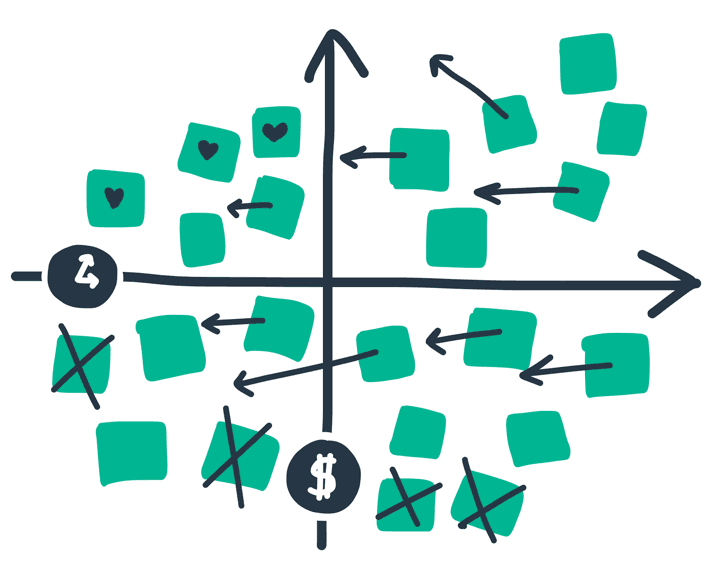
This exercise will give you a good understanding of where you’re investing time that you shouldn’t. Combined with your kanban board, it will identify high frequency, predictable value demands. For example: writing a blog post.
Can you find ways to cut down the time of high value and frequent tasks? Can you simplify or avoid low value tasks?
Having a clear view on the things you know you do a lot will make it evident where your team needs to get better. These are prime areas on which to focus your employee training and development. In time, you’ll have more efficient training sessions and more productive employees.
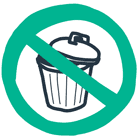
Figure out where you are wasting time and resources
Is work getting sent back? Are clients complaining?
All we are doing is looking at the time line, from the moment the customer gives us an order to the point when we collect the cash. And we are reducing the time line by reducing the non-value adding wastes.
Taiichi Ohno (1912-1990), about the Toyota Production System
Reducing waste (or muda, in Japanese) is also essential in service businesses.
PR agency FINN has cultivated the idea of reducing waste by reducing failure demand in their organization. Whenever a client failure demand occurs, employees share this experience with the rest of the team. This fosters learning within the team and gives employees a focus on improvement.
Here are some examples of common (and avoidable) failure demands:
- Client asks for a rewrite of press release.
Reasons: Team failed to get briefing and draft approved. Typos led to client questioning everything. - Media complains about too many and irrelevant press releases.
Reasons: Team has no overview of who is getting pitched. Contact database isn’t up-to-date. - Coverage isn’t secured as initial pitches aren’t being followed up.
Reasons: No one is tracking who pitched what and taking ownership of follow-ups.
Track the failure demands in your value overview quadrants chart. Visualize the waste on your Post-its to make it easy to refer back to the key issues.
You will be surprised at how much waste your company creates. Avoid waste at all costs. Directing your energy on creating value instead of waste is the direct route to higher profitability.
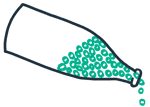
Find bottlenecks
Your Kanban board will make it easy to see where work is piling up. There will literally be tasks stuck in one column. Once you see this happening, you will need to act quickly to discover the bottlenecks causing these delays.
Here are some common examples of bottlenecks:
- Waiting for a colleague to source a previously used media list.
- Waiting for a team to update outdated contact list spreadsheets.
- Waiting for a designer to create social media visuals.
- Waiting for a client to sign off influencers you pitch.
- Waiting for a client to approve social media updates.
- Waiting for a client to upload assets to their newsroom.
- Waiting for a client to approve extra budget.
Often, a bottleneck happens because there are too many intermediaries involved in the process. They can also happen if there are too many people working on one task, losing time and information in handovers.
Overheads will be the lowest they can be when one person can complete a task from start to finish. In systems thinking terms: one person deals with each demand as it enters the system, right through to resolution for the customer, before acting on another demand.
For example: One team member discusses a blog post with a client, outlines it, writes it, publishes, schedules promotion on social media, sets up metrics, and reports to the client.
Map the people working on tasks to understand where you don’t have “single piece flow”. As an experiment, you could try removing people from a task to see if just one person can handle it better.
Of course, no single employee can handle every task. PR is a broad industry that calls on multiple competencies. For example, it would be unreasonable to expect everyone to be able to create a stellar infographic to accompany a blog post. In those cases, you’ll need to rely on help.
Every time a task gets handed over to someone else the likelihood of failure increases, and more waste is created. When a handover is necessary, make sure that the person taking on the responsibility has everything they need to take effective action. Have a clean handover. Again, have quality checklists to make sure that the work is complete and that it can be handed over with minimum errors and waste.

Find frustrating tasks
The Harvard Business Review focused its entire 2012 January-February issue on happiness. It found that the only route to employee happiness that also benefits shareholders comes from a sense of fulfillment from an important job done well.
Employees are happiest when they’re trying to achieve goals that are difficult but not out of reach.
Daniel Gilbert, The science behind the smile
Happy employees show up at work. They work harder, they don’t leave a company, and they attract others that share their drive.
Many factors contribute to employee happiness, but the most relevant one you can tackle right now is making sure employees do valuable work. The easiest way to find out what that is? Ask them.
Which tasks do team members detest? What work do they consider to be the most boring and repetitive?
If you’re not careful, this kind of discussion can turn into an unconstructive complaining session. You need to make sure this exercise stays valuable. A simple technique is to take the value overview your team has already worked on and implement “dot voting” for each task.
Give each team member an equal amount of “frustration dots”. Dot-stickers are ideal for this. Ask all participants to put the stickers on the tasks they find frustrating.
Take this real-life frustrating task as an example.
A while ago, I visited a top PR agency in London. This agency tracks influential Twitter users and their number of followers. A junior needs to do this by hand.
For a few hours every few weeks, this team member plows through an Excel sheet.
Copy/paste Twitter handle of a contact. Surf to the Twitter profile. Add the follower count to Excel sheet. Curse. Rinse. Repeat.
Utter madness. And probably not work for which this employee attained a PR degree.
This is an extreme example, but there will be several mind-numbing tasks in your company. Uncover them. Find ways to avoid them. Coworkers will thank you.
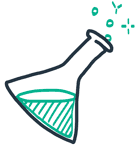
Pick experiments
You now have an overview of all the tasks your team currently does. You will also have an indication of which tasks are valuable, which ones are frustrating, where the team is making mistakes, and where bottlenecks are happening.
Now you need to decide which waste you’d like to reduce first. Will you take people out of the equation, change the order of the process, create checklists or different deliverables, or use different tools?
For example, if you decide to improve your media relations workflow, you might choose some specific experiments, such as:
- Structure and simplify reporting to clients.
- Simplify contact management.
- Make it easier to reuse previous outreach lists.
Now that you have chosen experiments, it’s time to take action.
3Assign project teams
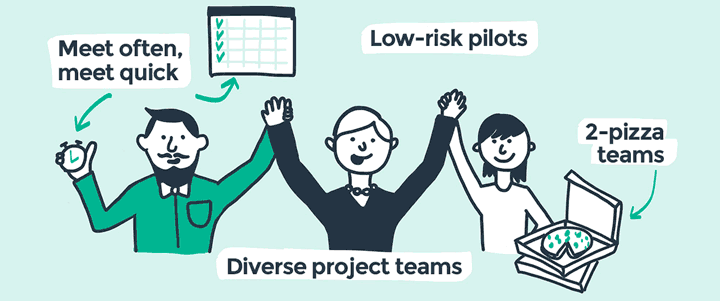
It is better to have a slightly better solution next week than to plan for a huge improvement in six months’ time.
Refrain from having lengthy meetings. Avoid the trap of a distant timeline by which you want to have the entire team using a new workflow. Instead, think kaizen. What are the smallest improvements you can make right now?
Do a low-risk pilot
Test before you invest: evaluate a new workflow before committing to it.
Start with a test project with a compact team. This will help you to learn fast what works.
It probably won’t be the best idea to experiment with a high stakes project with the difficult client and the impossible deadline. Choose a relatively safe project for which failure could be an option.
The best way we test tools at Weber is through pilot processes. We identify a client, we bring in technology for a campaign and then if it’s successful we can use that to demonstrate value. If people already see the value of the technology, they are already sold.
Danny Whatmough, Head of Social, EMEA, Weber Shandwick
If you’re cautious about venturing into unknown territory, you may even want to start with an internal project. How about the communication for your next corporate event?
Let’s imagine, for the sake of this exercise, that you have an upcoming event about content marketing with a high profile author as the main guest. And you want media attention for it.
Where do you start?
Choose small and agile teams
If you want to remain fast and agile, it’s necessary to keep your team small. At Amazon they refer to small teams as “two-pizza teams”.
If a project team can eat more than two pizzas, it’s too large.
Werner Vogels, Amazon’s Vice President and CTO
Productivity and team size: less is more
Amazon assigns tightly focused, small teams to solve one problem at a time. The Agile software development method has a similar approach: the recommended Agile team size is between five and nine members.
If you are doing a small experiment, you might even make your team membership even smaller.
In the earlier example, maybe one or two people are enough to test a new media outreach workflow for your corporate event.
These smaller, less risky experiments can be a good start to better understand agile methodologies. Progressive companies are overhauling their company structure to work more effectively. They’re moving away from the standard pyramid hierarchy with silos in favor of forming compact and agile groups that can solve problems much faster.
ING Netherlands, for example, now has 485 cross-functional teams, each comprising about nine people. Watch the following video for a quick overview of how they restructured their entire organization (you might want to skip to minute one).
In an interview with CoverageBook, ING Communications Director Johan Van Der Zanden shares more about ING’s journey to becoming agile.
![]()
Assemble a diverse project team
As when you started this process by reviewing your workflow, diversity remains important. The more diverse your team, the better the results.
In his book Group Genius, Keith Sawyer writes, “…when solving complex, non-routine problems, groups are more effective when they’re composed of people who have a variety of skills, knowledge, and perspective.” He goes on to say, “The reason groups are so effective at generating innovation is that they bring together far more concepts and bodies of knowledge than any one person can. Group genius can happen only if the brains in the team don’t contain all the same stuff.”
The simplest way to get a diverse group of employees could be to look at their job titles. If you match, for example, planners, account managers, producers, designers, and developers, you’ll have a diverse skills set and perspective.
A more thorough approach is to assess personality traits. The two most famous systems are the MBTI profiles and the Belbin team roles.
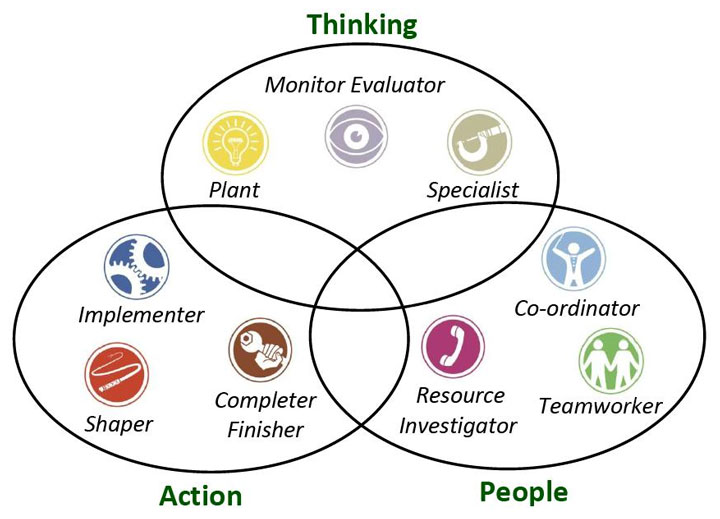
Belbin team roles. Visual by LeaderShip Solutions
A new PR workflow will probably incorporate a large technical component. Hence, it’s wise to invite brains with a lot of tech knowledge. Raise the geek-factor of your experiment team and include technical colleagues like web developers or systems administrators.
While such team members might not be necessary all of the time, their specialist advice can help with implementing technical solutions.
Keep momentum up with regular check-ins
Move fast and stay focused. Instead of having long weekly or monthly meetings, opt for frequent short meetings.
This approach has its merits in software development. Agile software development teams have “daily standups”.
It’s simple: teams get together once a day for the shortest amount of time possible. The point of difference between daily standups and your run-of-the-mill meeting? Attendees have to remain standing throughout the meeting.
The thinking behind daily standups is that it keeps the energy high. It also keeps the team focused on the main goal of the meeting: removing impediments so that the team can keep working fast.
In his book Scrum – The art of doing twice the work in half the time, Jeff Sutherland summarizes the daily standup as follows: “The Scrum Master, the person in charge of running the process, asks each team member three questions: 1. What did you do yesterday to help the team finish the Sprint? 2. What will you do today to help the team finish the Sprint? 3. What obstacles are getting in the team’s way? That’s it. That’s the whole meeting.”
If your meetings take more than 15 minutes, you’re doing it wrong.
Now that you have set up your team for success, let’s look at how team members can use technology to improve their workflow.
4Invest in automation and technology
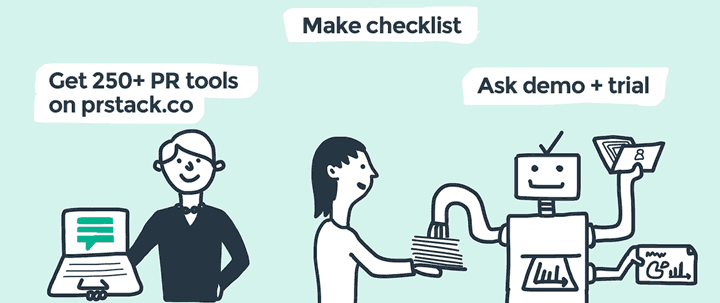
Can you imagine a sales team that doesn’t use a Customer Relations Management System (CRM)? Or a marketing team that doesn’t use marketing automation software?
Teams in most industries have adopted Software as a Service (SaaS) solutions to improve their workflow. The public relations industry is quite behind on this technological progress. A recent Arketi Group survey found that nearly half of the PR teams surveyed didn’t consider themselves knowledgeable on cloud technology, and 41 percent listed complexity as a technology challenge.
In recent years, many software solutions for communications teams have emerged. And they’re not just for big companies with big budgets. Most SaaS solutions are priced for teams of all sizes.
Here is how to get started.

Find and compare software in online catalogs
When you start Googling software solutions, you’ll likely get overwhelmed with the large number of solutions and all their different possibilities.
Start prepared. Know what you are looking for.
Review the problems that you’re trying to solve and make a quick list of your software requirements. Highlight what’s essential and what’s nice-to-have.
PRstack.co is the best place to begin your search. It is a crowdsourced catalog of 250+ PR tools and 48 guides.
PRstack is the definitive guide to practical public relations.
Francis Ingham, Director General PRCA, Chief Executive ICCO
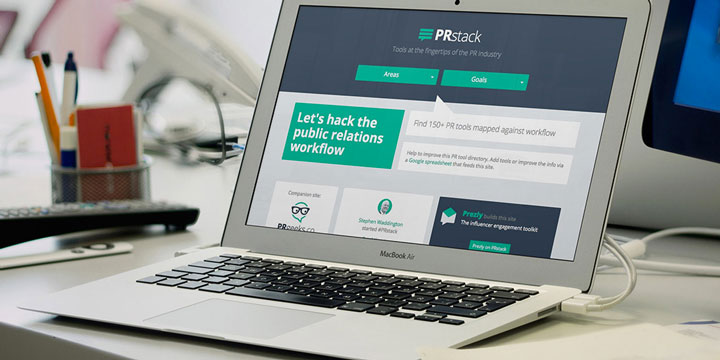
I have also created a more compact list of the 140 best PR tools and reviewed the five tools media relations tools you need for PR automation.
If you’re looking for non-PR specific tools, such as new accounting software, for example, head over to software portal Capterra.
Test the software
There are usually two ways to assess whether software is a good match: you can test run it (a trial) or you can let an expert show you around the software. A trial can take several hours, whereas a product demo takes about half an hour. Start with the latter: get a product demo and if you like what you see, ask for a test account.
Get a product tour in an online demo
Most online software vendors offer calls with a presales consultant. This is the fastest way to get an overview of software and to see whether the software will be a good match to your needs.
Software consultants are trained to understand your needs as fast as possible. They will probably start with asking you qualifying questions about your organization and what you want the software to do for you. A note of caution: some untrained vendors might dive into their software to give you a complete overview of every page and every button. This is, more often than not, a waste of valuable time.
Use your time wisely. Share your expectations with consultants before they start with the actual software demo. Explain that you only have half an hour and that you want to learn whether the software solves the problems that you have already outlined.
Example: Improve your influencer relations workflow
My team at outreach software builders Prezly helps communications teams get out of Excel hell.
Clients include big agencies like Ketchum, Grayling, and Ogilvy, and big brands like IKEA, Samsung, and Toyota. Many compact teams and one-person PR shops also use the software.
We’d be happy to give you a 30 minute demo.
Test before you invest – get a trial
So you found software and you want to start using it?
One piece of advice: fly under the radar.
At this point, you’re still trying to figure out whether the tool will actually help you improve your PR workflow. You only want to use it for your pilot project with a small team.
Try to get a free trial of the software. Many vendors provide it.
For more complex software, you might need to pay for the trial because the vendor will need to invest time to get you started.
Even if you have to pay for a trial, the budget might still be small enough to go below the radar of the procurement department.
Do not be overly concerned yet with the implications of rolling the software out to your entire team. And whatever you do, don’t involve your procurement department yet or you won’t learn anything for the next weeks. Or worse: you might end up buying software that in the end doesn’t solve your public relations workflow problems.
A trial will often last for one month or two weeks. Make sure you have all your ducks in a row when you start the trial so you can use the software to the fullest capability.
Now go play: try the new PR workflow for your pilot project and assess the results.
5Foster a learning culture
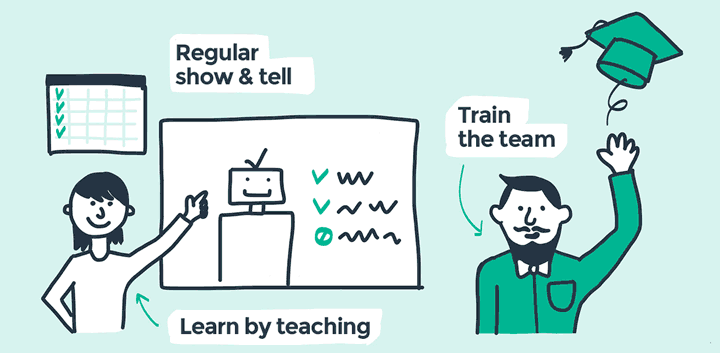
It would be a shame to stop your workflow improvement efforts now you’ve got the ball rolling and made some improvements.
The PR industry is changing so fast that change is becoming inherent to the job. Your team needs to keep up with and swiftly respond to evolving consumer behavior. Hence, it’s necessary that change becomes an organizational capability.
Change is the new business as usual. Firms need to find ways to adapt to continuous change.
Scott Guthrie, Founder Sabguthrie
A Communicator’s Guide to Successful Change Management
Do not limit yourself to a few experiments. Improving public relations workflow is a never-ending process that needs to be integral to your organization. Make it a part of the culture.
The teams that thrive the most have an open culture. One where people are encouraged to be curious, original, tolerate mistakes, and to be open to change.
Fortunately, PR teams could be the most well-equipped teams to deal with change management. After all, one of the biggest components of change is communication. It is sharing a clear goal and rallying the troops around this goal. That is what PR teams do best.
If you’d like to go deeper into change management, I recommend the free e-book A Communicator’s Guide to Successful Change Management by Craig Pearce.
Now let’s look at a few ways you can set your team up for continuous public relations workflow improvements.

Plan show and tell moments
Avoid letting the daily grind get in the way of your team’s learning journey. Make learning a habit by putting it on the agenda.
Leading PR agency Battenhall, for example, has learning lunches every Thursday. Team members take turns in sharing knowledge about new tools and developments.
If you have one foot firmly planted in the present, and the other a step ahead of your clients and competition, you will always be equipped for what the future holds.
Drew Benvie, Battenhall
PR will continue to struggle for an entire generation
Sessions such as weekly learning lunches are excellent opportunities for the workflow experiment teams to share their progress with the wider team.
Train the team
Are project teams convinced about the value of a new workflow? If not, how can you build credibility? Start by documenting it. Processes that are documented are easier to teach to new hires and make it easier to create quality checklists.
It is also important to take the time to teach the improved workflow to team members.
If we bring a new piece of technology into the business that no one has used before, the top thing we need to demonstrate to the people on the ground is how it will make their lives easier or add value.
Danny Whatmough, Head of Social, EMEA, Weber Shandwick
Although the value of ongoing learning is well-documented, the reality is that PR training doesn’t happen frequently enough. In a recent report by the Public Relations Consultants Association (PRCA), respondents highlighted the need for more training, especially in digital and social skills.
The main source of training for both in-house and agency people is via expert blogs. While it’s good news that professionals are taking the need to improve their skills seriously, it’s a shame that employers don’t take a stronger role.
You can learn a lot about how to be a star striker, tennis ace or racing driver from reading about it. It doesn’t make you Luis Suarez, Serena Williams or Lewis Hamilton. These people didn’t learn it from a blog. They practised and have trainers.
Stuart Bruce, PR trainer
PRCA Digital PR Report 2015: Need for more training
Some agencies do invest big in learning. Ketchum, for example, Europe’s biggest PR agency, recently upgraded their internal learning program and turned it into an award-winning collaborative online tool. Robert Burnside, the Chief Learning Officer at Ketchum, explains:
Classroom learning is too slow. By the time you set it up and teach it, it’s already out of date. We put the best knowledge out there and then let our community shape it.
Robert Burnside, Chief Learning Officer, Ketchum
Find out more more about their learning programme in this 20-minute podcast interview with Burnside.

Learn by teaching
One of the best ways to learn is by sharing what you learned. Blog about it, distribute a newsletter, or tweet latest developments.
It will push your team to stay fresh and on top of their game.
Consider this example.
The #1 PR blog worldwide is Spin Sucks. The owner is Arment Dietrich, an integrated marketing communications firm. Fresh content is published on the blog almost daily.
The team keeps pushing its skills because team members are sharing their expertise with an engaged community. Here is an example from Gini Dietrich, the CEO of Arment Dietrich:
Our blog has changed the way my team thinks. Just last night, we had a conversation about one client who keeps wanting links solely to their home page. Without the content at Spin Sucks, we’d have nothing to point to to say, “You really should link to specific pages and here’s data to back it up.
Gini Dietrich, Arment Dietrich
Knowledge sharing doesn’t necessarily have to be free. Because the Spin Sucks blog is so popular, Arment Dietrich also created a “pro” version where you can follow paywalled online courses: Spin Sucks Pro. Its own team is required to take the classes, do the homework, and get A grades.
Now that we’re talking about money: corporate blogging doesn’t just improve your skills. It can also benefit your business. According to the HubSpot State Of Inbound 2013, consistent blogging boosts inbound return on investment. Almost 80 percent of marketers with a company blog reported inbound ROI.
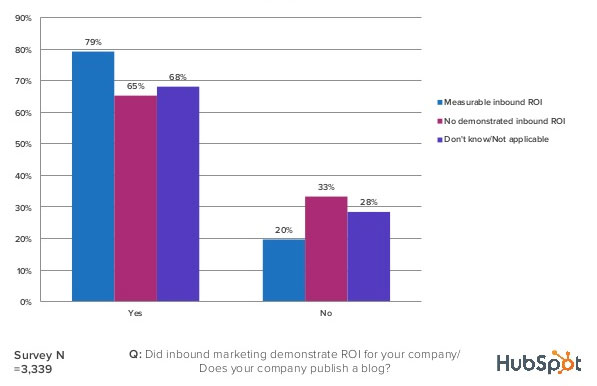
The State Of Inbound Marketing 2013 by HubSpot

Get professional help
This guide gives you a thorough roadmap to the change management process.
If you followed along this far, you’ll realize that this is a big endeavor, which will, in all likelihood, take a lot of effort to get started.
Increase your chances of success by hiring an expert consultant to help you kickstart the process. This expert will give you advice tailored to your situation and will keep you motivated to follow through with making improvements.
I recommend these PR consultants and change managers:
You have made it to the end of the guide.
Thanks for following along this far.
Are you inspired to get started right away? You first step is to get buy-in from seniors in your team. The following summaries will help you make your point:
- An overview presentation. This will also come in handy during a kickoff meeting.
- A poster of the entire process. Print it to motivate your team.
If you found the guide valuable, I’d love it if you’d share it on LinkedIn or Twitter.Would you like to share your experiences? Let me know via Twitter or via the contact form.
I am available to help you boost your public relations workflow. If you’d like me to lend a hand, contact me now.
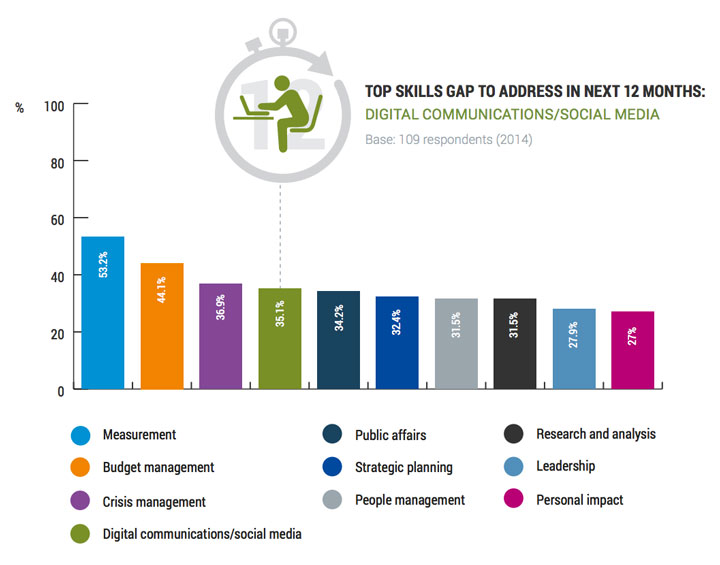
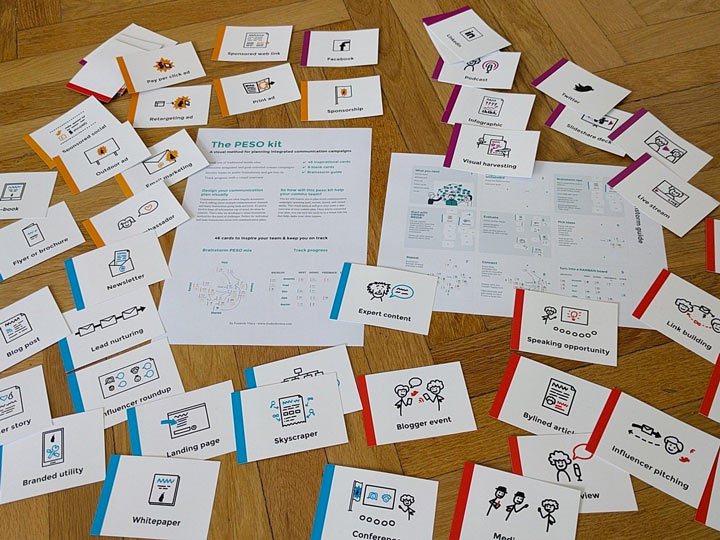
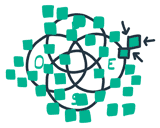
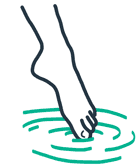
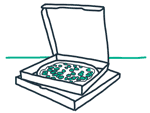



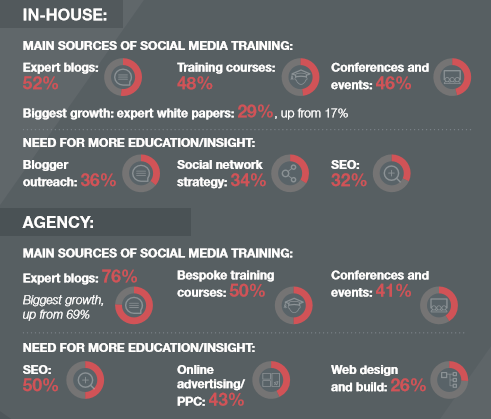
 Frederik Vincx
Frederik Vincx Stuart Bruce
Stuart Bruce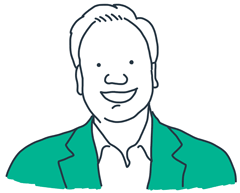 Scott Guthrie
Scott Guthrie